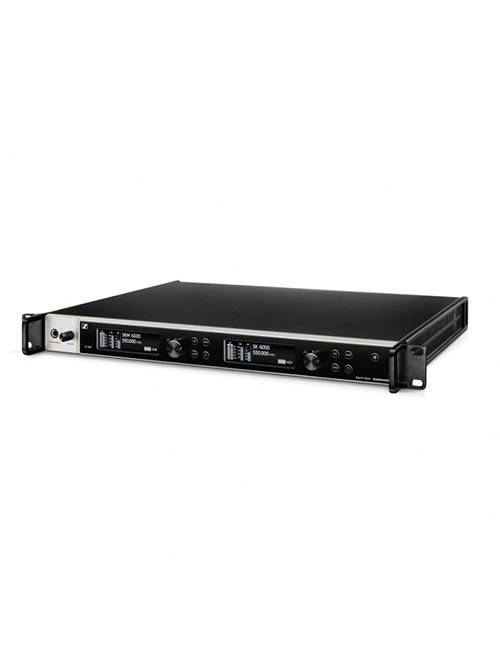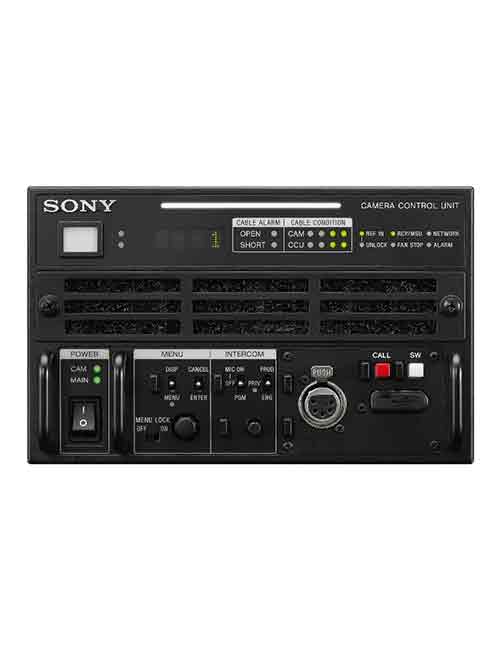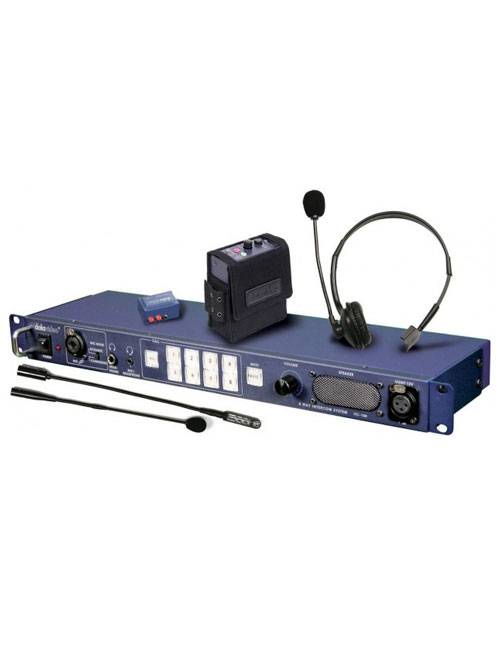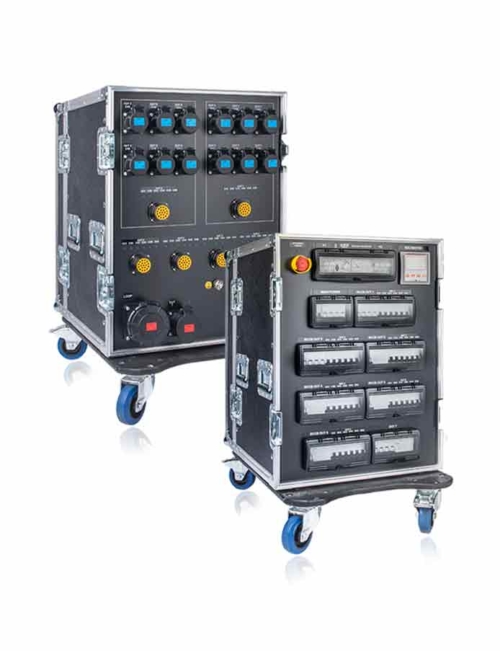-
 Sennheiser EM 6000 is a two-channel digital receiver and operates over a bandwidth of 244 MHz (470-714 MHz) that is covered by the three transmitter versions (470-558 MHz, 550-638 MHz, and 630-718 MHz). For multichannel systems, up to eight receivers can be cascaded without the need for an additional antenna splitter since it is built into the receiver itself; the multichannel system then operates with a single pair of antennas. System latency is 3 milliseconds. Superior reception, reliable audio Reliability has always been a hallmark of Sennheiser wireless systems, and Digital 6000 fulfills this promise by employing true bit diversity, transmission error correction, and additional intelligent error concealment. True bit diversity ensures significantly better reception quality than is available with other systems. While diversity or true diversity use the RF signal from a single antenna or the audio signal from a single receive path, respectively, true bit diversity uses both receive circuits and combines their information to create the optimum receive signal in this way. Digital 6000 receivers are equipped with a Link Quality Indicator that ensures that problems are seen before signal losses arise. If, as is the case in difficult RF environments, the signal was momentarily degraded to such an extent that transmission error correction could not perform any repair, the Digital 6000's intelligent error concealment is activated. By employing intelligent learning algorithms to replace the deteriorated signal, the Digital 6000 still transmits perfectly where other digital systems might fail. For data security, an especially important feature for conferencing and business use, Digital 6000 enables AES 256 encryption. The EM 6000 receiver features an easy-to-view white OLED display that provides a quick overview of the RF signal, link quality, audio signal, battery status, frequency and encryption. Several screens provide easy access to additional information without the user having to search through complicated sub-menus. Messages of critical operating and error conditions are shown directly on the display.
Sennheiser EM 6000 is a two-channel digital receiver and operates over a bandwidth of 244 MHz (470-714 MHz) that is covered by the three transmitter versions (470-558 MHz, 550-638 MHz, and 630-718 MHz). For multichannel systems, up to eight receivers can be cascaded without the need for an additional antenna splitter since it is built into the receiver itself; the multichannel system then operates with a single pair of antennas. System latency is 3 milliseconds. Superior reception, reliable audio Reliability has always been a hallmark of Sennheiser wireless systems, and Digital 6000 fulfills this promise by employing true bit diversity, transmission error correction, and additional intelligent error concealment. True bit diversity ensures significantly better reception quality than is available with other systems. While diversity or true diversity use the RF signal from a single antenna or the audio signal from a single receive path, respectively, true bit diversity uses both receive circuits and combines their information to create the optimum receive signal in this way. Digital 6000 receivers are equipped with a Link Quality Indicator that ensures that problems are seen before signal losses arise. If, as is the case in difficult RF environments, the signal was momentarily degraded to such an extent that transmission error correction could not perform any repair, the Digital 6000's intelligent error concealment is activated. By employing intelligent learning algorithms to replace the deteriorated signal, the Digital 6000 still transmits perfectly where other digital systems might fail. For data security, an especially important feature for conferencing and business use, Digital 6000 enables AES 256 encryption. The EM 6000 receiver features an easy-to-view white OLED display that provides a quick overview of the RF signal, link quality, audio signal, battery status, frequency and encryption. Several screens provide easy access to additional information without the user having to search through complicated sub-menus. Messages of critical operating and error conditions are shown directly on the display. -
 Sennheiser EM 6000 is a two-channel digital receiver and operates over a bandwidth of 244 MHz (470-714 MHz) that is covered by the three transmitter versions (470-558 MHz, 550-638 MHz, and 630-718 MHz). For multichannel systems, up to eight receivers can be cascaded without the need for an additional antenna splitter since it is built into the receiver itself; the multichannel system then operates with a single pair of antennas. System latency is 3 milliseconds. Superior reception, reliable audio Reliability has always been a hallmark of Sennheiser wireless systems, and Digital 6000 fulfills this promise by employing true bit diversity, transmission error correction, and additional intelligent error concealment. True bit diversity ensures significantly better reception quality than is available with other systems. While diversity or true diversity use the RF signal from a single antenna or the audio signal from a single receive path, respectively, true bit diversity uses both receive circuits and combines their information to create the optimum receive signal in this way. Digital 6000 receivers are equipped with a Link Quality Indicator that ensures that problems are seen before signal losses arise. If, as is the case in difficult RF environments, the signal was momentarily degraded to such an extent that transmission error correction could not perform any repair, the Digital 6000's intelligent error concealment is activated. By employing intelligent learning algorithms to replace the deteriorated signal, the Digital 6000 still transmits perfectly where other digital systems might fail. For data security, an especially important feature for conferencing and business use, Digital 6000 enables AES 256 encryption. The EM 6000 receiver features an easy-to-view white OLED display that provides a quick overview of the RF signal, link quality, audio signal, battery status, frequency and encryption. Several screens provide easy access to additional information without the user having to search through complicated sub-menus. Messages of critical operating and error conditions are shown directly on the display.
Sennheiser EM 6000 is a two-channel digital receiver and operates over a bandwidth of 244 MHz (470-714 MHz) that is covered by the three transmitter versions (470-558 MHz, 550-638 MHz, and 630-718 MHz). For multichannel systems, up to eight receivers can be cascaded without the need for an additional antenna splitter since it is built into the receiver itself; the multichannel system then operates with a single pair of antennas. System latency is 3 milliseconds. Superior reception, reliable audio Reliability has always been a hallmark of Sennheiser wireless systems, and Digital 6000 fulfills this promise by employing true bit diversity, transmission error correction, and additional intelligent error concealment. True bit diversity ensures significantly better reception quality than is available with other systems. While diversity or true diversity use the RF signal from a single antenna or the audio signal from a single receive path, respectively, true bit diversity uses both receive circuits and combines their information to create the optimum receive signal in this way. Digital 6000 receivers are equipped with a Link Quality Indicator that ensures that problems are seen before signal losses arise. If, as is the case in difficult RF environments, the signal was momentarily degraded to such an extent that transmission error correction could not perform any repair, the Digital 6000's intelligent error concealment is activated. By employing intelligent learning algorithms to replace the deteriorated signal, the Digital 6000 still transmits perfectly where other digital systems might fail. For data security, an especially important feature for conferencing and business use, Digital 6000 enables AES 256 encryption. The EM 6000 receiver features an easy-to-view white OLED display that provides a quick overview of the RF signal, link quality, audio signal, battery status, frequency and encryption. Several screens provide easy access to additional information without the user having to search through complicated sub-menus. Messages of critical operating and error conditions are shown directly on the display. -
 The HDCU-3500 camera control unit is designed for use with the Sony HDC-3500 and HDC-3500 4K/HD system cameras. It provides interfaces to external devices and power to the camera in a lightweight, portable half-rack housing (3U wide) that is ideal for OB production environments. 12G-SDI and 4K output is available via the optional HZCU-UHD35 software licence. The CCU also provides an optional path for IP functionality with the HDC Series fibre-optic studio cameras. Tally support for IP (TSL UMD v5.0) is available as standard, while CCU menu settings can be conveniently changed remotely via a network
The HDCU-3500 camera control unit is designed for use with the Sony HDC-3500 and HDC-3500 4K/HD system cameras. It provides interfaces to external devices and power to the camera in a lightweight, portable half-rack housing (3U wide) that is ideal for OB production environments. 12G-SDI and 4K output is available via the optional HZCU-UHD35 software licence. The CCU also provides an optional path for IP functionality with the HDC Series fibre-optic studio cameras. Tally support for IP (TSL UMD v5.0) is available as standard, while CCU menu settings can be conveniently changed remotely via a network -

Features:
- 2-Channel Headset/Speaker Main Station with built-in 2-amp power supply, rack mount (1RU) - UL Listed
- Compact, feature-laden, single rack-space intercom main station supports up to 40 RS-601 beltpacks, 10 speaker stations or 12 headset stations on two channels.
Other features include:
- Channel A-B linking
- Program input with individual channel level controls
- Remote Mic Kill switch
- External relay circuit
- Stage Announce
-

63A (3PH+N+E) CEE IN, direct OUT with six 19-pin SSX connectors (standard SOCA) and 2 more 19-pin SSX connectors, mated with twelve single phase 16A CEE sockets. All lines are protected by 6-channel 30mA RCD and MCBs per each channel. In addition: Digital multimeter (DMM) with six 3-digit displays for 3-phase voltage and current control. Red pilot-light for IN voltage, green pilot-light for OUT voltage, helping to keep PBox IN and OUT lines well managed.


